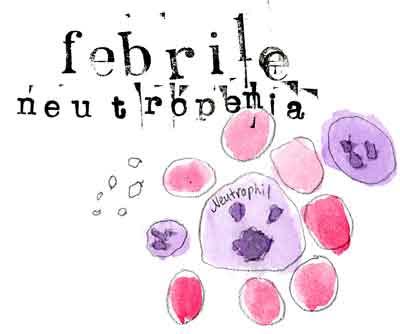Neutropenic Fever
Neutropenia is defined as an absolute neutrophil count (ANC) < 500 cells/mm3 (or 1000 cells/mm3 with expected decrease to 500)
o ANC=WBC x (neutrophil%+bands%)
Mild: 1000 – 1500
Mod: 500 – 1000
Severe: 100 – 500
Profound: <100
Causes of neutropenia
o Chemotherapy - Kills not only cancer cells but also infection fighting neutrophils
o Drugs (clozapine, methimazole, sulfa drugs), Sepsis, Autoimmune diseases (SLE, RA), Transplants, Alcoholism, Myelodysplastic syndrome, Viral illnesses
Neutropenic Fever is defined as a fever of 38C (100.4F) plus ANC <500 cells/mm3
o Most severe in those suffering from hematological malignancies
o Mortality reduced from 90% to 2-21% with early antibiotics
ED Management
o Full set of labs (Lactate level, CBC, BMP, blood culture x 2, UA, urine culture)
o CXR
o CT head with LP if indicated (high suspicion for meningitis) or unknown source
o *skin exam (decubs, cellulitis); *ORAL exam (mucositits)
o IVF
o **Antibiotics
o Isolation if possible
Common infectious agents
o Gram negative organisms (E. Coli, Klebsiella, Pseudomonas)
o MRSA, MSSA, Strep viridans
First line antibiotics
o Zosyn OR Cefepime OR Ceftazadime OR Carbapenem — Though pseudomonal infection is actually uncommon, bacteremia from it is quite concerning; therefore, your AB regimen (even if single) should always include coverage against it
o Add Vancomycin if concerned for gram positive bug— Ie: prior MRSA infections, cellulitis, mucositis, already on gram negative prophylaxis
o Adjustments based on past history/colonization
MRSA: vanc, linezolid, daptomycin
Pseudomonas/ESBL: carbapenems
Klebsiella: polymyxin-colistin, tigecycline
o Add antiviral and antifungal medications if clinical suspicion high
*interestingly, low risk patients based on MASCC or CISNE scoring systems and good oncology follow up can be considered for outpatient management with augmentin+ciprofloxacin. Obviously, this is at the discretion of the ED team.
Neutropenic Enterocolitis aka Typhlitis
o Triad: triad of neutropenia + fever + RLQ pain
o Bacterial invasion of intestinal mucosa causing necrotizing abdominal infection
o Conservative management with AB unless peritoneal/bowel perforated
o Up to 50% mortality
Resources:








